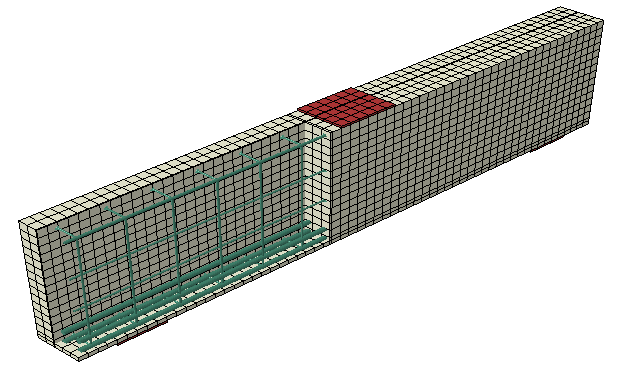Non-Linear Finite Element Analysis of RC Deep Beam Using CDP Model
DOI:
https://doi.org/10.46604/aiti.2021.5407Keywords:
nonlinear finite element, reinforced concrete deep beam, concrete damage plasticity, abaqusAbstract
Finite element analysis (FEA) is widely adopted these days to investigate relatively heavy structures such as reinforced concrete (RC) deep beam, which requires a higher investment of resources. This research aims to investigate a numerical modeling technique applicable to study the nonlinear behavior of RC deep beams by using FEA based on the software, ABAQUS. The nonlinear behavior of an RC deep beam adapted from an earlier research work is captured by using the uniaxial compressive and tensile stress-strain relationship and damage parameters of concrete. The response of the FE model is verified with the experimental results in terms of the load to midspan deflection curve and damage distribution. The ultimate shear capacity predicted by the FE model is 0.75% lower, and the corresponding displacement is 6.92% higher than the experimental results. The adopted modeling technique and the constitutive concrete models demonstrate the promising results indicating its possibilities for the investigation of RC structures.
References
Y. Dere, A. Asgari, E. D. Sotelino, and G. C. Archer, “Failure Prediction of Skewed Jointed Plain Concrete Pavements Using 3D FE Analysis,” Engineering Failure Analysis, vol. 13, no. 6, pp. 898-913, September 2006.
A. R. Mohamed, M. S. Shoukry, and J. M. Saeed, “Prediction of the Behavior of Reinforced Concrete Deep Beams with Web Openings Using the Finite Element Method,” Alexandria Engineering Journal, vol. 53, no. 2, pp. 329-339, June 2014.
Building code Requirements for Structural Concrete, ACI 318-14, ACI Standard, 2014.
G. Hussein, S. H. Sayed, N. E. Nasr, and A. M. Mostafa, “Effect of Loading and Supporting Area on Shear Strength and Size Effect of Concrete Deep Beams,” Ain Shams Engineering Journal, vol. 9, no. 4, pp. 2823-2831, December 2018.
B. S. Young, J. M. Bracci, P. B. Keating, and M. B. D. Hueste, “Cracking in Reinforced Concrete Bent Caps,” Structural Journal, vol. 99, no. 4, pp. 488-498, 2002.
P. Rai and K. Phuvoravan, “Shear Behavior of RC Deep Beam Strengthened by V-Shaped External Rods,” International Journal of Engineering Technology Innovation, vol. 10, no. 1, pp. 41-59, January 2019.
A. Earij, G. Alfano, K. Cashell, and X. Zhou, “Nonlinear Three–Dimensional Finite–Element Modelling of Reinforced–Concrete Beams: Computational Challenges and Experimental Validation,” Engineering Failure Analysis, vol. 82, pp. 92-115, December 2017.
“Abaqus Users Manual, Version 6.13-2,” http://130.149.89.49:2080/v6.11/books/usb/default.htm, August 02, 2020.
J. Lubliner, J. Oliver, S. Oller, and E. Oñate, “A Plastic-Damage Model for Concrete,” International Journal of Solids and Structures, vol. 25, no. 3, pp. 299-326, 1989.
J. Lee and G. L. Fenves, “Plastic-Damage Model for Cyclic Loading of Concrete Structures,” Journal of Engineering Mechanics, vol. 124, no. 8, pp. 892-900, August 1998.
A. Hamoda, A. Basha, S. Fayed, and K. Sennah, “Experimental and Numerical Assessment of Reinforced Concrete Beams with Disturbed Depth,” International Journal of Concrete Structures and Materials, vol. 13, no. 1, p. 55, 2019.
H. Behnam, J. S. Kuang, and B. Samali, “Parametric Finite Element Analysis of RC Wide Beam-Column Connections,” Computers & Structures, vol. 205, pp. 28-44, August 2018.
J. D. Nzabonimpa, W. K. Hong, and J. Kim, “Nonlinear Finite Element Model for the Novel Mechanical Beam-Column Joints of Precast Concrete-Based Frames,” Computers & Structures, vol. 189, pp. 31-48, September 2017.
A. S. Genikomsou and M. A. Polak, “Finite Element Analysis of Punching Shear of Concrete Slabs Using Damaged Plasticity Model in ABAQUS,” Engineering Structures, vol. 98, pp. 38-48, September 2015.
V. Birtel and P. Mark, “Parameterised Finite Element Modelling of RC Beam Shear Failure,” ABAQUS Users’ Conference, 2006, pp. 95-108.
A. Demir, N. Caglar, and H. Ozturk, “Parameters Affecting Diagonal Cracking Behavior of Reinforced Concrete Deep Beams,” Engineering Structures, vol. 184, pp. 217-231, April 2019.
S. Popovics, “A numerical Approach to the Complete Stress-Strain Curve of Concrete,” Cement Concrete Research, vol. 3, no. 5, pp. 583-599, September 1973.
E. Thorenfeldt, A. Tomaszewicz, and J. J. Jensen, “Mechanical Properties of High-Strength Concrete and Applications in Design,” Symposium on Utilization of High-Strength Concrete (Stavanger, Norway), Tapir, Trondheim, Norway, 1987.
A. Belarbi and T. T. Hsu, “Constitutive Laws of Concrete in Tension and Reinforcing Bars Stiffened by Concrete,” Structural Journal, vol. 91, no. 4, pp. 465-474, July 1994.
X. B. D. Pang and T. T. Hsu, “Behavior of Reinforced Concrete Membrane Elements in Shear,” Structural Journal, vol. 92, no. 6, pp. 665-679, November 1995.

Published
How to Cite
Issue
Section
License
Submission of a manuscript implies: that the work described has not been published before that it is not under consideration for publication elsewhere; that if and when the manuscript is accepted for publication. Authors can retain copyright in their articles with no restrictions. is accepted for publication. Authors can retain copyright of their article with no restrictions.
Since Jan. 01, 2019, AITI will publish new articles with Creative Commons Attribution Non-Commercial License, under The Creative Commons Attribution Non-Commercial 4.0 International (CC BY-NC 4.0) License.
The Creative Commons Attribution Non-Commercial (CC-BY-NC) License permits use, distribution and reproduction in any medium, provided the original work is properly cited and is not used for commercial purposes.







